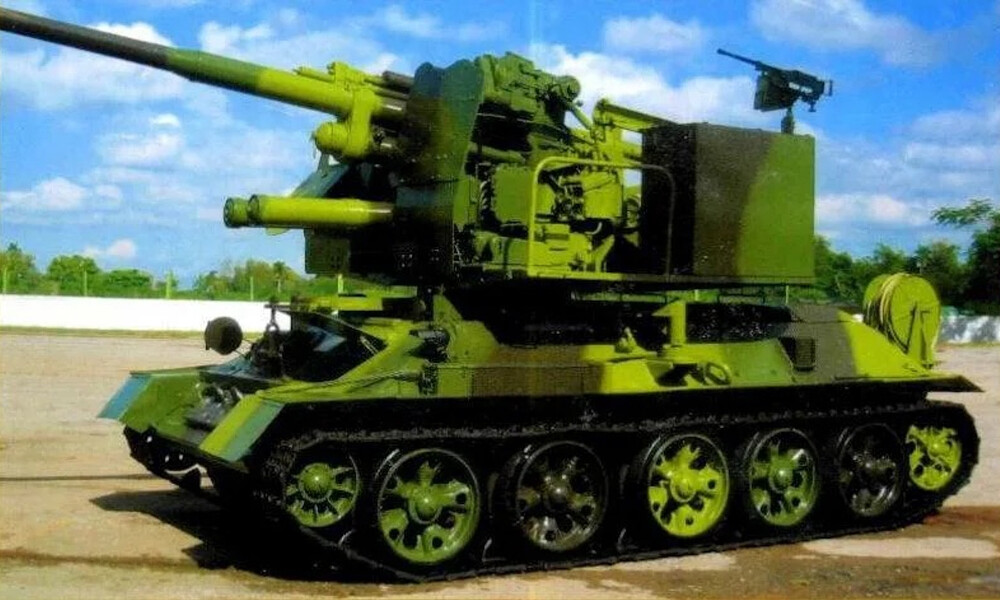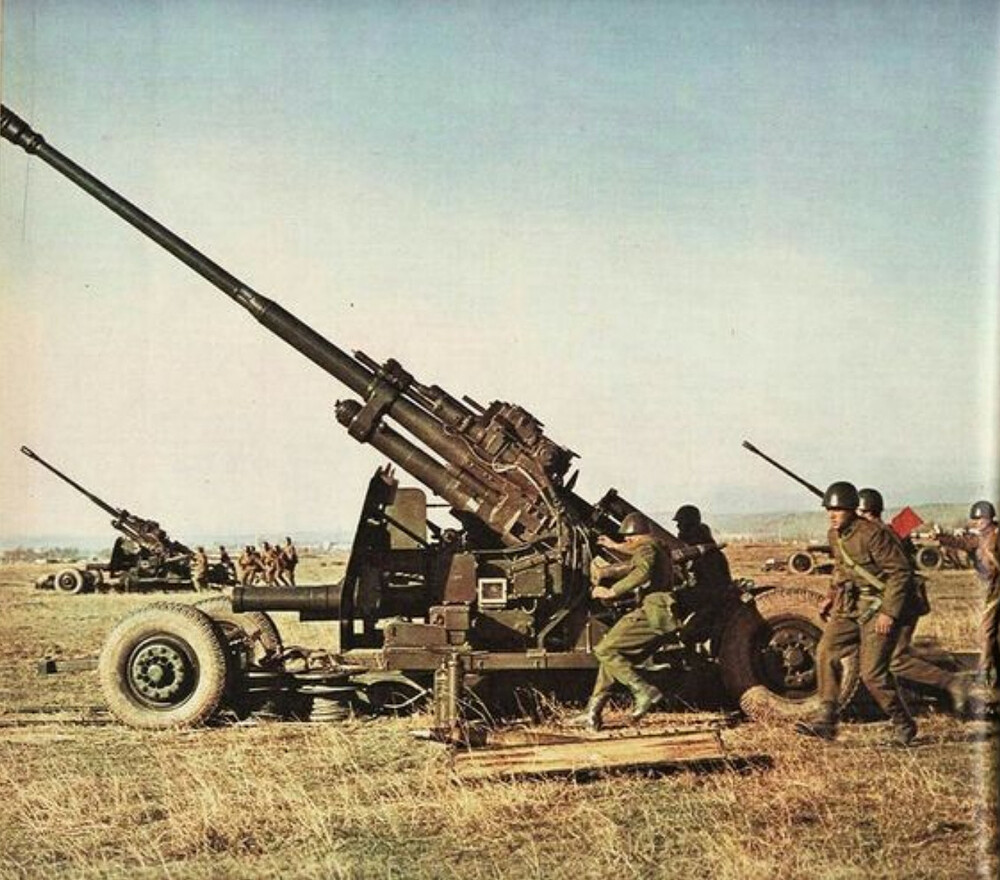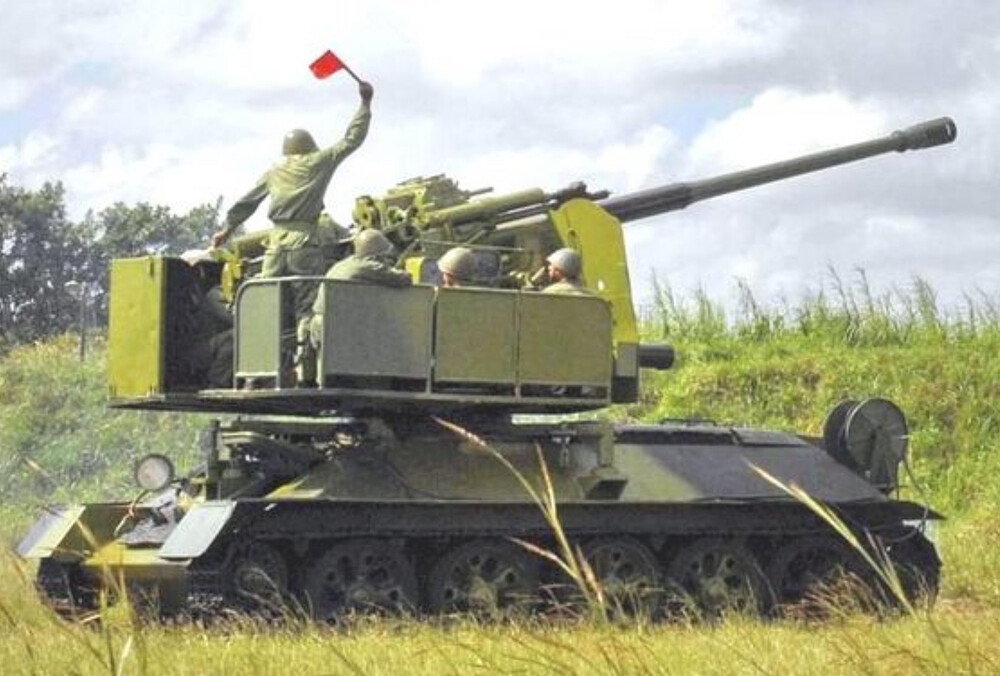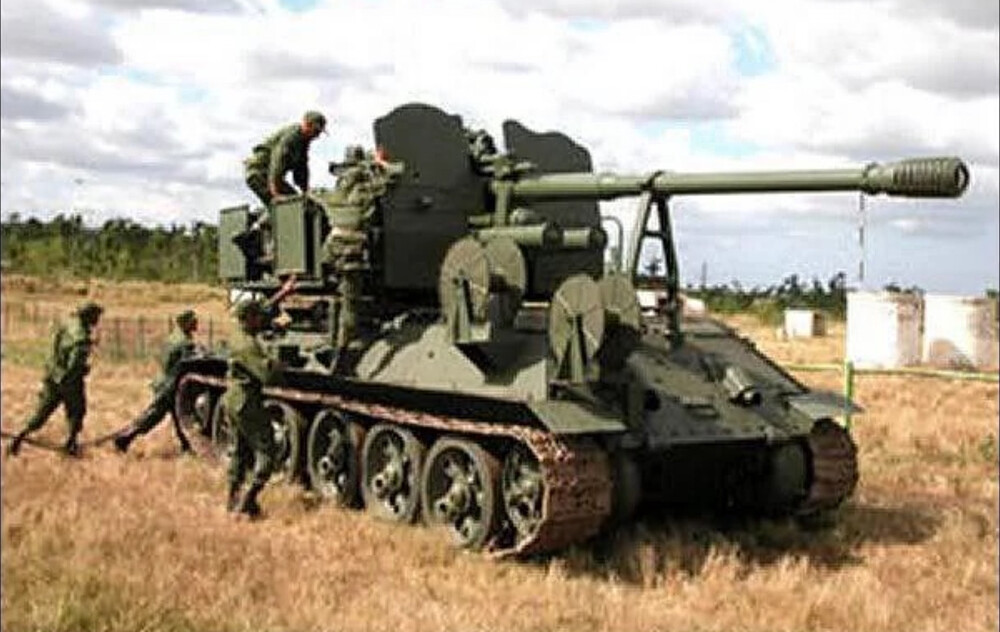Would you like to see AAPMP-100 in-game?
Where would you like to see it in-game?
- In the Soviet Tree
- In the Cuban Tree
- In an Alternative Tree
- No, I don’t want to see this in-game
AAPMP-100 (T-34/KS-19)
During the Cold War, Cuba found itself with a significant stockpile of Soviet T-34-85 tanks, many of which were modernized
Model 1969s. These upgrades gave the venerable World War II tank a second life and helped it soldier on until the end of the century. While these changes extended the tanks’ operational lifespan, by the late 20th century the T-34-85 was hopelessly obsolete as a frontline battle tank. However, its mobility was still excellent. Rather than scrap these relics outright, Cuban engineers took an inventive approach: transforming the old hulls into improvised self-propelled artillery and anti-aircraft platforms. To them it was clear that static weapons positions could not survive for long in a modern conflict against a technologically advanced adversary like the United States. Thus, they managed to kill two birds with one stone.
Among the most striking examples of this ingenuity is the
AAPMP-100 or
C-AP-MP-T-100 armed with the powerful Soviet
KS-19 100 mm anti-aircraft gun. The KS-19 was
the largest Soviet anti-aircraft gun ever fitted to a vehicle, and overall it was the second most-powerful mass-produced Soviet flak piece, surpassed only by the
KS-30 in power and reach.
KS-19 In-depth
Spoiler
The KS-19, introduced by the Soviet Union in the late 1940s, was originally designed to counter high-altitude bombers before guided missile technology became the norm. It is a large, heavy towed gun, weighing nearly ten tones in combat trim and requiring a seven-man crew at minimum. Its long 100 mm barrel launches shells at roughly 900 meters per second, sending high-explosive or armor-piercing rounds to targets as far as twenty-one kilometers away. At maximum elevation, the gun can engage aerial threats flying up to twelve to fifteen kilometers above ground, making it an impressive piece of mid-century air defense technology. The KS-19 could fire up to fifteen rounds per minute with a semi-automatic breech and power-assisted ramming mechanism, and it worked best when linked to radar fire control stations common in Soviet air defense networks. Its shell could reach its maximum altitude in 1.5 minutes.
Over its service life, several improved versions appeared:
- KS-19M: Minor updates to the breech and barrel for smoother operation and improved durability.
- KS-19M2: Mounted on a sturdier carriage with reinforced outriggers to handle repeated heavy firing and simplify deployment.
The KS-19 was designed to operate most effectively when integrated into a larger air defense network rather than firing in isolation. In Soviet service, it was typically deployed in batteries linked to radar directors such as the SON-9 (“Fire Can”), which tracked targets and relayed precise range and bearing data to analog fire-control computers like the PUAZO series. This combination allowed crews to adjust elevation and traverse automatically or with minimal manual input, greatly improving accuracy against fast-moving aircraft. Interestingly, Cuban C-AP-MP-T-100 show heavy cable reels and wiring brackets attached to the vehicle, suggesting that these self-propelled guns were intended to connect directly to similar fire-control radars and directors when deployed in anti-aircraft roles. By retaining this wired guidance capability, Cuban forces could maximize the gun’s original high-altitude engagement potential while also exploiting its mobility to reposition quickly after firing.
Beyond its anti-aircraft role, the KS-19 also proved capable against ground targets. It could deliver powerful high-explosive fragmentation shells or penetrate tank armor up to around 180 millimeters at close to medium ranges, a performance on par with Soviet 100 mm field guns like the BS-3. Some ammunition variants even included advanced sub-caliber or shaped-charge projectiles, further improving its anti-armor capability.
The KS-19 was capable of firing a broad selection of 100 mm shells, sharing ammunition with the Soviet BS-3 anti-tank gun. Typical ammunition included:
- High-Explosive Fragmentation (HE-FRAG): Standard rounds for anti-aircraft and general-purpose use. These shells weighed roughly 15–16 kg and were equipped with automatically timed fuses to detonate near the aircraft.
- Armor-Piercing (AP-T and APC-T): Solid shots or capped rounds designed to penetrate thick armor. These rounds could defeat around 180 mm of homogeneous armor at close ranges, making the gun effective in an anti-tank role if needed.
- Armor-Piercing Discarding Sabot (APDS): Specialized tungsten-cored projectiles with higher muzzle velocity — rare but boosting penetration against more modern tanks.
- HEAT (High-Explosive Anti-Tank): Some late-era stocks included shaped-charge rounds capable of penetrating over 250 mm of armor, useful against heavy tanks or fortifications.
- Practice and tracer shells: For gunnery drills and training without live warheads.
AAPMP-100 In-depth
Spoiler
Cuba’s adaptation of this formidable gun onto a tank chassis turned an immobile anti-aircraft piece into a self-propelled gun with greater tactical flexibility. To create this hybrid, the T-34-85’s original enclosed turret was completely removed. In its place, Cuban workshops installed a robust mounting structure to hold the KS-19’s carriage and recoil system, allowing the gun to elevate and rotate freely. The result is an open-topped fighting compartment with minimal overhead protection. The improved T-34-85 Model 1969s came with upgraded engines (500-520 hp) providing the necessary power to move this massive cannon between firing positions, a major advantage over the original towed version, which required separate transport and time-consuming setup. While the gun mount allows full 360-degree rotation, firing is highly likely typically conducted over the rear arc to better manage the recoil forces on the chassis and avoid causing unnecessary damage to the engine and transmission.
These converted vehicles have been seen in Cuban live-fire exercises, where they appear to serve as mobile howitzers. However, the presence of heavy cable reels indicates that they could still be integrated with fire-control radars and directors, allowing them to perform effectively in their original anti-aircraft role, provided the supporting equipment remains operational and available. Less romantically, those cable reels simply connect to a separate generator to power the cannon’s electrical mechanisms, allowing faster elevation and traverse. If disconnected, the gun must rely on manual cranks and might be noticeably slower to move around. Nevertheless, even in manual mode, the slew and elevation speeds remain satisfactory.
Based on available photographs and the distinct camouflage patterns visible on each vehicle, it is clear that this conversion exists in more than one example. At least one of these hybrids is fitted with a 7.62 mm machine gun (SGMB?) mounted on the loader’s side, installed on what appears to be an ammunition storage box. Although the box is not particularly large, it likely holds around 10 to 20 rounds for the 100 mm gun. A precise estimate of its capacity would benefit from a detailed 3D reproduction of the vehicle, which could clarify its dimensions and internal arrangement.
While far from modern standards of protection, the combination of a powerful 100 mm gun with a fast tracked chassis makes this improvised vehicle a credible threat to light armor, fortifications, and low-flying aircraft or helicopters in a regional conflict or in War Thunder. However, that ammunition box may be its Achilles’ heel in any case. I’m also not sure whether the now-empty hull contains any additional ammunition for the weapon.
AAPMP-100 — Specifications
Spoiler
Vehicle Type:
Improvised self-propelled gun or self-propelled anti-aircraft gun.
Origin:
Republic of Cuba — based on a Soviet T-34-85 Model 1969
Crew:
~ 6–7
Dimensions (approximate):
Length (overall, gun forward): ~8.2 meters
Width: ~3.0 meters
Height (to gun shield): ~2.7–3.0 meters
Ground clearance: ~0.4 meters
Combat Weight:
Approx. 32 metric tons.
Engine:
V-2-34M-11 12-cylinder diesel producing 520 horsepower.
Power-to-Weight Ratio:
About 16.2 hp/ton.
Mobility:
Max road speed: ~50–55 km/h (flat terrain).
Operational range: ~300 km (on road, full fuel).
Suspension: Christie coil-spring bogies with upgraded T-55 style starfish wheels.
Transmission: 5-speed manual.
Armament:
Main gun: KS-19 100 mm AA cannon on rotating pedestal mount.
Muzzle velocity: ~900–905 m/s.
Rate of fire: up to 13–15 rpm (ideal conditions).
Effective AA ceiling: ~12–15 km.
Max ground range: ~20–21 km indirect fire.
Maximum traverse speed: ~18–20 degrees per second.
Maximum elevation speed: ~15–20 degrees per second.
Ammunition: HE-FRAG, AP-T, APC-T, APDS (limited), HEAT, training rounds.
Possible pintle-mounted 7.62 mm MG for defense.
Gun Mounting & Fire Control:
The KS-19 is mounted on a reinforced pedestal, allowing full 360-degree traverse and wide elevation from –3° to +85°. Heavy cable reels suggest the gun can connect to external radar and PUAZO predictors for coordinated anti-aircraft fire, mirroring the original battery setup but with added mobility.
Protection:
Hull: standard T-34-85 armor (45 mm sloped glacis, 45–52 mm sides).
Gun shield: about 6–10 mm steel, covering the frontal arc only.
Fighting compartment: open-topped with a frontal gun shield only; no overhead protection.
Sources
View
Cuban Domestic Military Production - Combat Vehicles
The Oryx Handbook Of Cuban Fighting Vehicles - Oryx
KS-19
The Cuban army gave a second life to the T-34 and T-55 tanks



